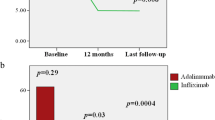Abstract
Adalimumab (Humira®) is a tumour necrosis factor (TNF)-α inhibitor available in various countries worldwide, including the USA, Japan and those of the EU, for the treatment of non-infectious intermediate, posterior and panuveitis in adults. It is the first biological agent approved for this indication. In two multinational, phase III studies in adults with active and inactive disease, subcutaneous adalimumab significantly reduced the risk of treatment failure relative to placebo following the tapered withdrawal of corticosteroid therapy. Significant differences favouring adalimumab over placebo were seen for each component of treatment failure (vitreous haze, new active inflammatory lesions, anterior chamber cell grade and a worsening of best-corrected visual acuity) in patients with active disease and for the visual acuity component in patients with inactive disease. Adalimumab was also significantly more effective than placebo in improving multiple aspects of uveitic inflammation in patients with active, but not in those with inactive, disease. Adalimumab was generally well tolerated in these patient populations. Its tolerability profile was consistent with the known tolerability profile of the agent in other indications and no new safety signals were identified. Moreover, the incidence of anti-adalimumab antibodies was low. Thus, adalimumab is an effective and generally well tolerated treatment option in adults with non-infectious intermediate, posterior and panuveitis, including those who cannot be treated with corticosteroids.
Similar content being viewed by others
References
Airody A, Heath G, Lightman S, et al. Non-infectious uveitis: optimising the therapeutic response. Drugs. 2016;76(1):27–39.
Schwartzman S, Schwartzman M. The use of biologic therapies in uveitis. Clin Rev Allergy Immunol. 2015;49(3):307–16.
Levy-Clarke G, Jabs DA, Read RW, et al. Expert panel recommendations for the use of anti-tumor necrosis factor biologic agents in patients with ocular inflammatory disorders. Ophthalmology. 2014;121(3):785–96.
AbbVie Inc. HUMIRA (adalimumab) injection, for subcutaneous use: US prescribing information. 2016. http://www.fda.gov/. Accessed 2 Feb 2017.
AbbVie GK. AbbVie and Eisai obtain additional approval for new indication of fully human anti-TNF-α monoclonal antibody HUMIRA® in the treatment of non-infectious uveitis. 2016. http://www.eisai.com/. Accessed 2 Feb 2017.
AbbVie Ltd. Humira (adalimumab): EU summary of product characteristics. 2016. http://www.ema.europa.eu/ema/. Accessed 2 Feb 2017.
European Medicines Agency. Humira (adalimumab): extension of indication variation assessment report. 2016. http://www.ema.europa.eu/ema/. Accessed 2 Feb 2017.
Grebe KM, Salfeld J, Kaymakcalan Z. Lack of adalimumab’s complement dependent cytotoxicity on human cells expressing complement regulatory proteins. J Transl Med. 2010;8(Suppl 1):9.
Calleja S, Cordero-Coma M, Rodriguez E, et al. Adalimumab specifically induces CD3+ CD4+ CD25high Foxp3+ CD127- T-regulatory cells and decreases vascular endothelial growth factor plasma levels in refractory immuno-mediated uveitis: a non-randomized pilot intervention study. Eye. 2012;26(3):468–77.
Cordero-Coma M, Calleja S, Llorente M, et al. Serum cytokine profile in adalimumab-treated refractory uveitis patients: decreased IL-22 correlates with clinical responses. Ocul Immunol Inflamm. 2013;21(3):212–9.
Jaffe GJ, Dick AD, Brézin AP, et al. Adalimumab in patients with active noninfectious uveitis. N Engl J Med. 2016;375(10):932–43.
Nguyen QD, Merrill PT, Jaffe GJ, et al. Adalimumab for prevention of uveitic flare in patients with inactive non-infectious uveitis controlled by corticosteroids (VISUAL II): a multicentre, double-masked, randomised, placebo-controlled phase 3 trial. Lancet. 2016;388(10050):1183–92.
Suhler EB, Jaffe GJ, Nguyen QD, et al. Long-term safety and efficacy of adalimumab in patients with non-infectious intermediate, posterior, or panuveitis in an ongoing open-label study [abstract no. 1335]. Arthritis Rheumatol. 2016;68(Suppl 10).
Adan A, Foster CS, Pathai S, et al. Efficacy and safety of adalimumab in active and inactive noninfectious uveitis patients with and without immunosuppressant use at baseline [abstract no. PO429]. In: American Academy of Ophthalmology Annual Meeting. 2016.
Brézin A, Chen N, Tari S, et al. Clinical relevance of treatment failure as assessed by the 25-Item Visual Functioning Questionnaire in patients with intermediate-, posterior- and pan-uveitis: results from the VISUAL-1 trial [abstract no. THU0565]. Ann Rheum Dis. 2016;75(Suppl 2):396.
Naik RK, Gries KS, Rentz AM, et al. Psychometric evaluation of the National Eye Institute Visual Function Questionnaire and Visual Function Questionnaire Utility Index in patients with non-infectious intermediate and posterior uveitis. Qual Life Res. 2013;22(10):2801–8.
Landewé R, van der Horst-Bruinsma I, Tari S, et al. Quiescence in active and inactive non-infectious, intermediate, posterior, or panuveitis in patients treated with adalimumab [abstract no. 3077]. Arthritis Rheumatol. 2016;68(Suppl 10).
Acknowledgements
During the peer review process, the manufacturer of adalimumab was also offered an opportunity to review this article. Changes resulting from comments received were made on the basis of scientific and editorial merit.
Author information
Authors and Affiliations
Corresponding author
Ethics declarations
Funding
The preparation of this review was not supported by any external funding.
Conflicts of interest
Sheridan Hoy is a salaried employee of Adis/Springer, is responsible for the article content and declares no relevant conflicts of interest.
Additional information
The manuscript was reviewed by: A. Airody, Academic Unit of Ophthalmology, York Teaching Hospitals NHS Foundation Trust, York, UK; A. P. Brézin, Université Paris Descartes, Hôpital Cochin, Paris, France; L. Cimino, Ocular Immunology Service, Ophthalmology Unit, Arcispedale Santa Maria Nuova – IRCCS, Reggio Emilia, Italy; C. Pavesio, Moorfields Eye Hospital NHS Foundation Trust, London, UK.
Rights and permissions
About this article
Cite this article
Hoy, S.M. Adalimumab: A Review in Non-Infectious Non-Anterior Uveitis. BioDrugs 31, 135–142 (2017). https://doi.org/10.1007/s40259-017-0213-x
Published:
Issue Date:
DOI: https://doi.org/10.1007/s40259-017-0213-x




